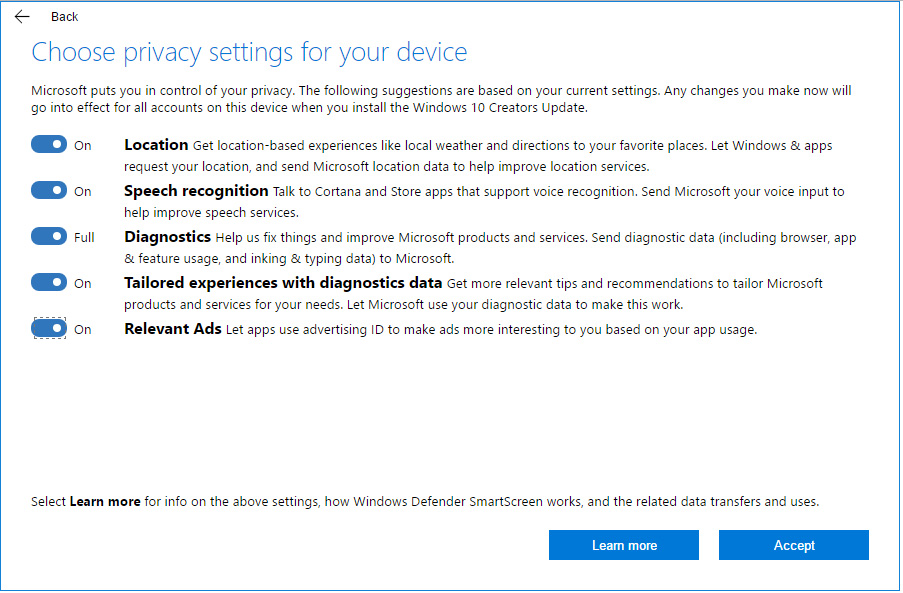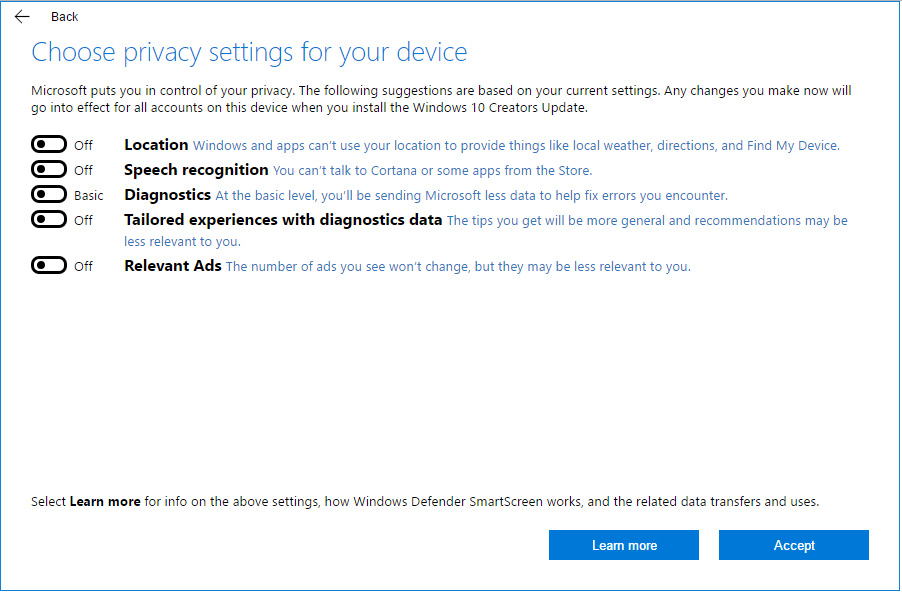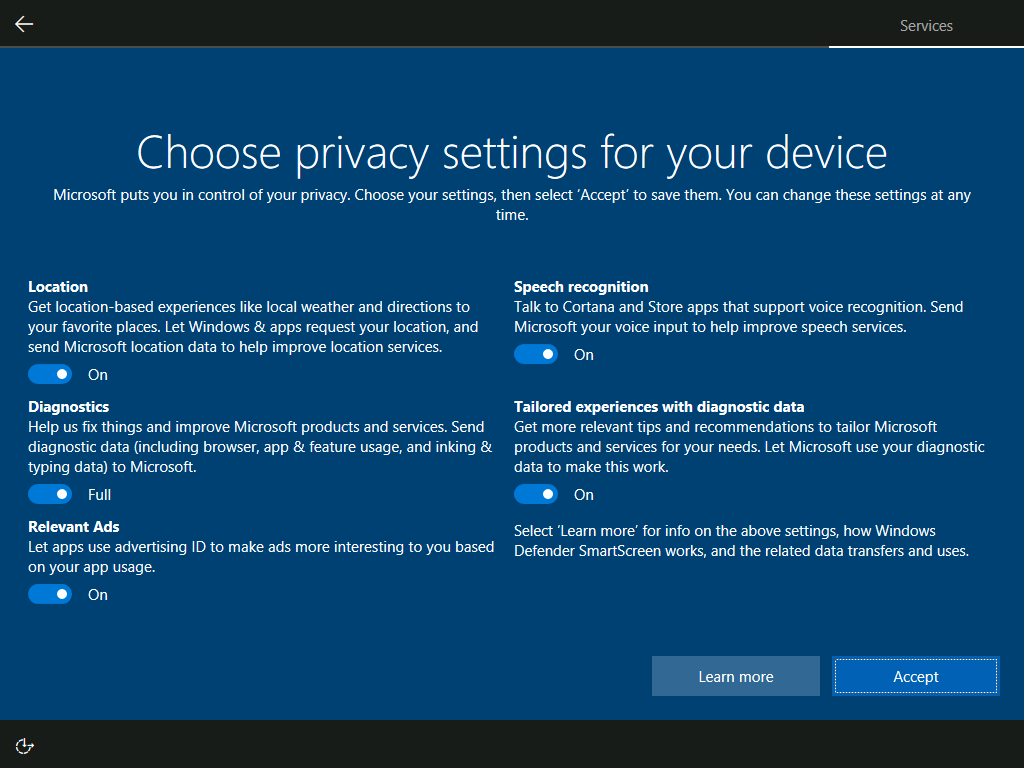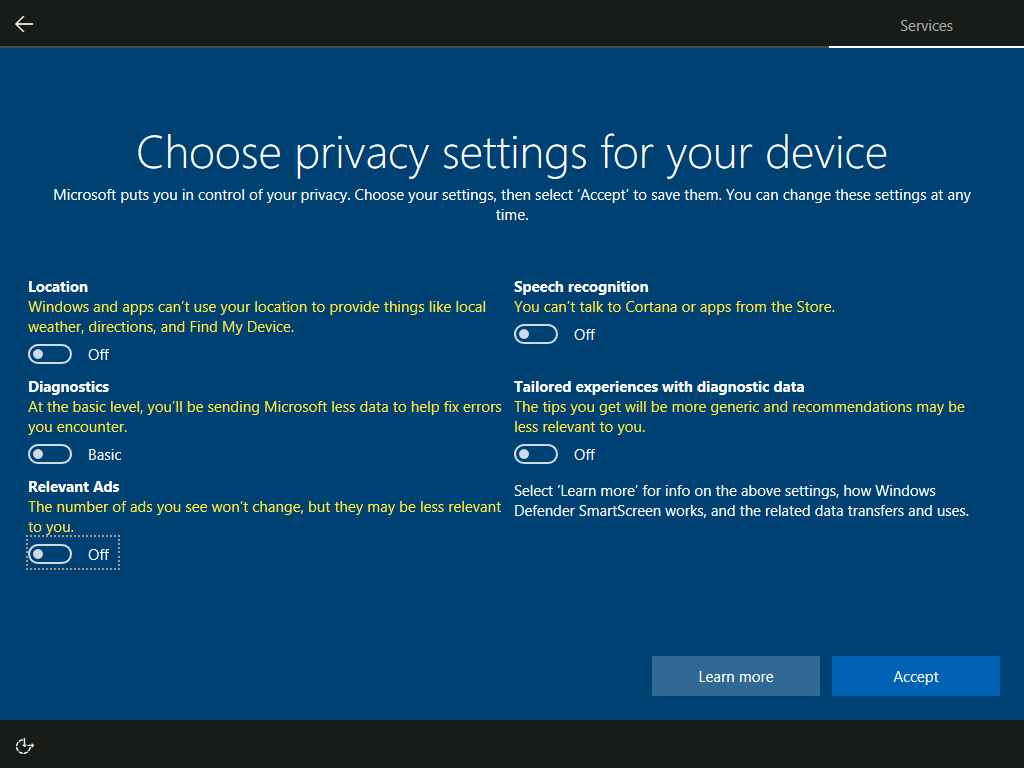Microsoft Opens Up About Privacy In Windows 10 Creators Update
Microsoft offered another peek at the privacy settings you'll be asked to manage before you install the looming Windows 10 Creators Update. The company said in a blog post that it will collect less information than before, offer more details about what each setting does, and respect the decisions you've already made with previous versions of Windows 10 when the Creators Update starts to roll out between April 5 and April 11.
Privacy concerns have plagued Windows 10 for a while. Microsoft previously encouraged you to share information when you got started with the operating system, and when the Anniversary Update debuted in August 2016, it removed the ability to easily disable the Cortana virtual assistant. You could still control what it could access--ranging from your emails and installed apps to your speech and location data--but not turn it off.
That problem remains in the Creators Update. Now, though, Microsoft requires you to set each individual setting before you get started, which means its data collection should come as less of a surprise, and the company has worked to reduce the amount of information it collects. These reductions are particularly noticeable in regard to diagnostic info, as Windows and Devices Group EVP Terry Myerson explained in the blog post:
Aside from sharing new information to inform your choices, our teams have also worked diligently since the Anniversary Update to re-assess what data is strictly necessary at the Basic level to keep Windows 10 devices up to date and secure. We looked closely at how we use this diagnostic data and strengthened our commitment to minimize data collection at the Basic level. As a result, we have reduced the number of events collected and reduced, by about half, the volume of data we collect at the Basic level.
Microsoft doesn't allow you to opt out of sending diagnostic information from the Settings app. You can choose from only three levels: Basic, Enhanced, and Full. The company recommends the Full setting, but the other two are still options. (The biggest problem with choosing Basic is that it prevents you from submitting comments via the Feedback Hub.) Limiting the amount of data you're required to share is a welcome change.
The Creators Update will also make it easier to figure out what each setting does. Why does Microsoft want you to provide your location, enable speech recognition, and let it use your data to offer "tailored experiences" and targeted ads? Right now that isn't clear, but this update will offer more details about each item and provide a "Learn more" link that lets you get even more information about how the settings affect your privacy.




Operating system updates offer companies a good chance to reset user settings. You might prevent Windows 10 from accessing your location or showing relevant advertisements now, but if you weren't paying attention while setting up the Creators Update, perhaps those settings could have been changed to help Microsoft earn some more ad revenue. Free operating system updates aren't going to pay for themselves, you know.
Get Tom's Hardware's best news and in-depth reviews, straight to your inbox.
Microsoft didn't go that route. Instead, the company said that each setting will respect the choices you've already made. You'll still have to go through the setup process--the whole point is making sure people are clear on what data Windows 10 shares--but you won't have to disable each individual setting another time. This is a small decision, to be sure, but it still helps to highlight Microsoft's renewed commitment to user privacy.
Or at least that's the idea. We'll have a better understanding of Microsoft's approach to user privacy in this new era of Windows-as-a-service after we've spent a little time with the Creators Update. For now you can check out Microsoft's updated Privacy Statement to learn more about what data is collected and how it's used, and if you have a hankering for the Creators Update, you should be able to install it at some point later today.

Nathaniel Mott is a freelance news and features writer for Tom's Hardware US, covering breaking news, security, and the silliest aspects of the tech industry.
-
Dark Lord of Tech Your privacy settings won't really matter , they will still collect the information regardless of what settings you choose.Reply -
dstarr3 "Microsoft doesn't allow you to opt out of sending diagnostic information from the Settings app. You can choose from only three levels: Basic, Enhanced, and Full. The company recommends the Full setting..."Reply
HURRRRR DUH DERP DERP I WONDER WHY DERP DERP DERP -
3ogdy Exactly. They just give people the sense of control, but they still secretly steal information from users, even if the options are "Off". "Relevant ads"? LmFao, how about "No ads and duck off"?Reply
"Privacy", as they call it. Privacy concerns in Windows 10 are real, ESPECIALLY with Trump as a president. -
As I said before Windows 10 was even released, this OS is trash...incredible how much they collect and how much they won't tell you about. OS is the biggest trash ever released.Reply
-
ajpaolello Reply19522483 said:Your privacy settings won't really matter , they will still collect the information regardless of what settings you choose.
People seem to often forget about that fact. Whether you keep them on or off they collect anyway. You don't really have a say. -
nzalog 2017 when the OS is its own spyware/spam.Reply
I get that they pretty much gave windows 10 away for free but they really should not be charging for the OS at all at this point. -
wiyosaya Reply19522913 said:2017 when the OS is its own spyware/spam.
I get that they pretty much gave windows 10 away for free but they really should not be charging for the OS at all at this point.
Sooner or later, M$ will figure out that their experiment with 10 has failed.
In the meantime, I hope that figure out how to not break something with this update since they pretty much have done so with every update from the anniversary update on. -
Morbus I am still using Windows 7 and have completely disabled Windows Update and all spying services on the OS since late 2015.Reply
Life has been amazing. All I need is NoScript in my Firefox and not install any BS software and bliss and amazement.
Unless someone tries to hack my machine directly, then I'm toast :P But I'm sure I'd be toast with W10 anyway. -
kittle Yet one more reason for me to keep using windows 7 and NOT upgrade.Reply
+1 for adblock in your browser. next we will need an adblock for the OS level.
